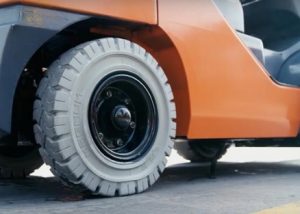When Should You Replace Forklift Tires?
If you are a forklift operator, then one of the most important aspects of forklift maintenance is knowing when it’s time to change the lift’s tires. Moreover, state and federal law requires that forklift operators be trained in forklift wheel and tire maintenance.
No doubt you want to ensure the full life span of your car’s tires. This should also be the case for your forklift tires. As with your car, it starts with selecting the proper tire for the forklift and the tasks that it performs. There are assortments of parameters that need to be considered. These include:
- Tire Usage
- Operator Driving Habits
- Condition of the Floor
- Condition of the Job Site
- Tire Type
Forklift tire usage is measured in hours, not miles.
As with cars, the driver’s driving habits including quick stops and starts, sharp turns, driving too fast, and spinning tires would adversely affect the life of the tires.
It should also be a given for operators of forklifts that a smooth surface results in longer lasting tires. Rough or coarse surfaces as well as debris on the surface will damage tires over time.
Humidity on the job site can cause condensation on floors that can result in tire spin that cause more wear and tear.
And, as far as tire type is concerned, pneumatic tires puncture and tend to wear faster than more durable solid pneumatic tires. Press-on polyurethane tires tend to last twice as long as cushion tires.
Forklift Tires May Need Repair
Wear and tear is obviously the enemy of tires, but circumstances may lead to the repair of tires, too. Factors that could cause a need to repair a tire include:
- Contact With Chemicals
- Heat
- Uneven Driving Surfaces
- Under-inflation
Chemicals that are frequently found in warehouses and that can cause damage to tires that would lead to a need to repair include gasoline, oils, and grease. Constant contact of a tire to these chemicals cause wear patterns that result in blowouts.
Heat can buildup on a forklift tire due to especially long shifts and cause the rubber to soften and change support and can cause tire rubber to strip off a tire.
Surfaces that are uneven and bumpy or made of debris like loose rocks and gravel can result in damaged tires that would require repair or replacement.
Under-inflated tires will wear much quicker than when the tire is properly inflated.
When To Replace Forklift Tires
You can determine whether or not tires need to be replaced by observing the following:
- Tread wear or Balding
- Cuts or Tears
- Chunking
- Flat Spots

Chemicals in warehouses can damage tires. (Courtesy: Camso)
Discovering tread wear or balding of your forklift tires is essential before you attempt to operate it. Pneumatic and cushion tires are less effective when their tread is low. For pneumatic tires, when the tread is mostly removed or you observe bald spots, then replacing the tire is essential. When the size of a cushion tire is 2-inches less than when it was new, then it is time to replace it, too.
A cut or torn tire must be expected over time. When you discover that one tire is cut or torn, it’s best to replace all the tires of your forklift to ensure safe operation.
Chucking occurs on cushion tires and happens when the tire comes into contact with a sharp object like dock plates or scrap metal. Tires with missing chunks are unsafe and should be replaced immediately.
Flat spots occur when a tire is misaligned or due to sharp stops when the lift is carrying heavy loads. Obviously, chunked tires must be replaced and the employee who is operating the forklift with tires in this condition should be retrained.
Changing A Forklift Tire
It is suggested that you change the two tires on the same axle when one of those tires is damaged for safety reasons, even if the other tire has plenty of tread.
If your warehouse owns a tire press, than changing a forklift tire is a fairly easy undertaking.
- Use a jack to lift the truck.
- Unscrew and remove the wheel.
- Remove the tire from the wheel
- Attach the wheel to the tire press and then press the new tire onto the wheel.
- Reattach the wheel to the forklift
- Lower the jack to the ground.
- Remove the jack from the forklift.
- Test for proper balance and rolling of the tires.
The federal government’s Occupational Safety and Health Administration (OSHA) requires that companies that use forklifts should have a maintenance plan for them. The plan should include a process of knowing when to replace forklift tires. Forklift operators should also know how to inspect tires for damage and wear.
It is suggested that for safety sake, you replace forklift tires once a year.
(Source: Forkliftcertification.com)
